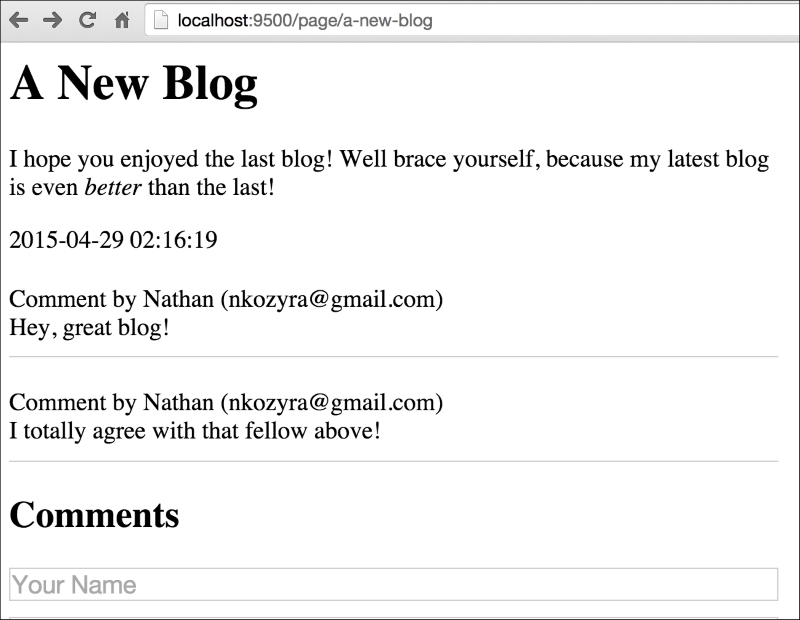Now that we have a security certificate in place, we can switch to TLS for our API calls for both GET and other requests. Let's do that now. Note that you can retain HTTP for the rest of our endpoints or switch them at this point as well.
Note
Note: It's largely becoming a common practice to go the HTTPS-only way and it's probably the best way to future-proof your app. This doesn't solely apply to APIs or areas where explicit and sensitive information is otherwise sent in cleartext, with privacy on the forefront; major providers and services are stressing on the value of HTTPS everywhere.
Lets add a simple section for anonymous comments on our blog:
<div id="comments">
<form action="/api/comments" method="POST">
<input type="hidden" name="guid" value="{{Guid}}" />
<div>
<input type="text" name="name" placeholder="Your Name" />
</div>
<div>
<input type="email" name="email" placeholder="Your Email" />
</div>
<div>
<textarea name="comments" placeholder="Your Com-ments"></textarea>
</div>
<div>
<input type="submit" value="Add Comments" />
</div>
</form>
</div>This will allow any user to add anonymous comments to our site on any of our blog items, as shown in the following screenshot:

But what about all the security? For now, we just want to create an open comment section, one that anyone can post to with their valid, well-stated thoughts as well as their spammy prescription deals. We'll worry about locking that down shortly; for now we just want to demonstrate a side-by-side API and frontend integration.
We'll obviously need a comments table in our database, so make sure you create that before implementing any of the API:
CREATE TABLE `comments` ( `id` int(11) unsigned NOT NULL AUTO_INCREMENT, `page_id` int(11) NOT NULL, `comment_guid` varchar(256) DEFAULT NULL, `comment_name` varchar(64) DEFAULT NULL, `comment_email` varchar(128) DEFAULT NULL, `comment_text` mediumtext, `comment_date` timestamp NULL DEFAULT NULL, PRIMARY KEY (`id`), KEY `page_id` (`page_id`) ) ENGINE=InnoDB DEFAULT CHARSET=latin1;
With the table in place, let's take our form and POST it to our API endpoint. To create a general purpose and a flexible JSON response, you can add a JSONResponse struct that consists of essentially a hash-map, as shown:
type JSONResponse struct {
Fields map[string]string
}Then we'll need an API endpoint to create comments, so let's add that to our routes under main():
func APICommentPost(w http.ResponseWriter, r *http.Request) {
var commentAdded bool
err := r.ParseForm()
if err != nil {
log.Println(err.Error)
}
name := r.FormValue("name")
email := r.FormValue("email")
comments := r.FormValue("comments")
res, err := database.Exec("INSERT INTO comments SET comment_name=?, comment_email=?, comment_text=?", name, email, comments)
if err != nil {
log.Println(err.Error)
}
id, err := res.LastInsertId()
if err != nil {
commentAdded = false
} else {
commentAdded = true
}
commentAddedBool := strconv.FormatBool(commentAdded)
var resp JSONResponse
resp.Fields["id"] = string(id)
resp.Fields["added"] = commentAddedBool
jsonResp, _ := json.Marshal(resp)
w.Header().Set("Content-Type", "application/json")
fmt.Fprintln(w, jsonResp)
}There are a couple of interesting things about the preceding code:
First, note that we're using commentAdded as a string and not a bool. We're doing this largely because the json marshaller does not handle booleans elegantly and also because casting directly to a string from a boolean is not possible. We also utilize strconv and its FormatBool to handle this translation.
You might also note that for this example, we're POSTing the form directly to the API endpoint. While an effective way to demonstrate that data makes it into the database, utilizing it in practice might force some RESTful antipatterns, such as enabling a redirect URL to return to the calling page.
A better way to approach this is through the client by utilizing an Ajax call through a common library or through XMLHttpRequest natively.
Note
Note: While internal functions/method names are largely a matter of preference, we recommend keeping all methods distinct by resource type and request method. The actual convention used here is irrelevant, but as a matter of traversing the code, something such as APICommentPost, APICommentGet, APICommentPut, and APICommentDelete gives you a nice hierarchical way of organizing the methods for better readability.
Given the preceding client-side and server-side code, we can see how this will appear to a user hitting our second blog entry:

As mentioned, actually adding your comments here will send the form directly to the API endpoint, where it will silently succeed (hopefully).
